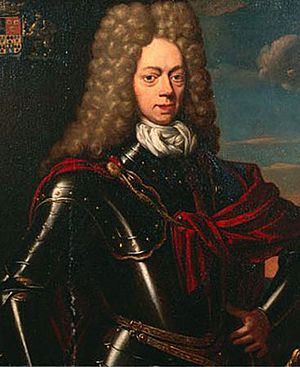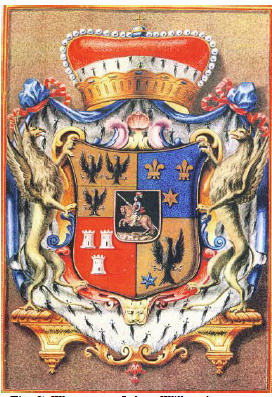John William, Baron Ripperda facts for kids
Quick facts for kids
The Most Excellent
The Duke of Ripperdá
|
|
|---|---|
 |
|
| Prime Minister of Spain | |
| In office 12 December 1725 – 14 April 1726 |
|
| Monarch | Philip V |
| Preceded by | José de Grimaldo |
| Succeeded by | José de Grimaldo |
| Personal details | |
| Born |
Johan Willem Ripperda
|
| Nationality | Dutch, Spanish |
Juan Guillermo Ripperdá was a fascinating person who became a powerful politician in Spain. He was born in the Netherlands in 1684 and later became the Prime Minister of Spain. He passed away in 1737 in Tétouan. He was known for his adventurous spirit and his journey through different careers and countries.
Contents
Early Life and Family
Juan Guillermo Ripperdá was born in 1684 in Oldehove, Netherlands. His birth name was Johan Willem Ripperda. He came from a very old and important noble family called the Ripperdas. This family was well-known in the Groningen area of the Netherlands.
He was born into the Roman Catholic faith. He went to a Jesuit school in Cologne. Later, he changed his religion to Calvinism. He did this to be elected as a representative for Groningen in the Dutch government.
Dutch Ambassador to Spain
In 1715, the Dutch government sent Ripperdá to Madrid, Spain. He served there as an ambassador. Some people at the time questioned his honesty. However, Spain was a place where foreigners could become very successful. This was true for people like Jean Orry and Giulio Alberoni.
Ripperdá decided to work for the Spanish government. He also changed his religion back to Roman Catholicism. He first worked closely with a minister named Alberoni. After Alberoni lost power, Ripperdá became an agent for Queen Elizabeth Farnese. She was the wife of King Philip V and had a lot of influence over him.
Ripperdá was very good at understanding business and trade. He pointed out that Spain's poverty was mainly because it didn't focus enough on its farming. However, his success came more from helping the queen with her plans. She wanted her sons to inherit important areas in Italy, like Parma and Tuscany.
Spanish Envoy to Vienna
In 1724, Ripperdá was sent as a special representative to Vienna. This was a very important diplomatic mission. During this time, he was given the high title of duke.
After ten months of talks, a series of agreements were made. These are known as the Treaty of Vienna (1725). Through these agreements, the Austrian government promised very little. However, a company called the Ostend Company gained trading rights in the Spanish colonies. Spain, on the other hand, agreed to pay large amounts of money. This was difficult for Spain's treasury, which was already low on funds.
The Austrian Emperor hoped to get money from Spain. Queen Elizabeth Farnese hoped to secure Italian territories for her sons. There were also some talks about Spain getting back Gibraltar and Menorca.
When Ripperdá returned to Madrid in late 1725, he claimed that the Emperor wanted him to become prime minister. The Spanish King and Queen believed him. So, they made him the minister of foreign affairs. He used his new position to gain quick profits. This made many people angry, both from other countries and within Spain. The Austrians wanted the money they were promised. The English and Prussian governments were upset by his actions. The Spanish people were unhappy because he lowered the value of their money.
End of His Spanish Career
Ripperdá's time as a top minister was short. In 1726, the Austrian representative came to Spain. He wanted to know why the promised payments had not been made. It was then discovered that Ripperdá had made promises he wasn't allowed to make. He had also taken large amounts of money for himself.
The King and Queen had made him a duke and a grandee. They did not want to look foolish by revealing how they had been tricked. So, Ripperdá was dismissed from his job. He was promised a pension. By May 1726, he was involved in many secret plans with the French and British governments.
He sought safety at the British ambassador's home in Madrid. To gain the ambassador's favor, he shared government secrets. However, the ambassador could not protect him. Ripperdá was then sent as a prisoner to the castle of Segovia.
Later Years and Travels
In 1728, Ripperdá escaped from prison. It is thought that the government might have helped him escape. He then went to Holland. His life after this became less clear.
Some stories say he changed his religion back to Protestantism. Then, he supposedly went to Morocco. There, he is said to have become a Muslim. He might have even led the Moors in an attack on Ceuta, which was not successful. However, these stories come from his so-called Memoirs. These were actually adventure tales published in 1740. What is truly known is that he did go to Morocco. He died there in Tetuan in 1737.
Marriages and Family
Ripperdá was married two times. His first wife was Aleida van Schellingwoude. From her, he inherited important land titles. Their son, Ludolph Luirdt, also became a Spanish ambassador to Vienna. Their daughter, Maria, married a Spanish Count.
His second wife was Francisca de Xarava del Castillo from Spain. They had two sons. Their youngest son, Juan María Vicencio de Ripperdá, became a Spanish officer. He also served as Governor of Texas and Honduras.
Ripperdá escaped Spain with the help of a servant girl named Josepha Francisca Ramos. They had a son named Francois Joseph. His family members still live near Lingen in Germany and across the United States.
Images for kids
See also
 In Spanish: Juan Guillermo Ripperdá para niños
In Spanish: Juan Guillermo Ripperdá para niños



